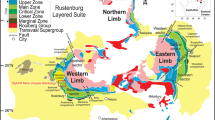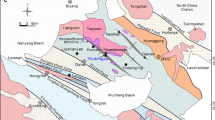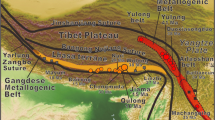Abstract
The Kurrat–Girar–Badwar greenstone sequence on the southern part of Bundelkhand Craton consists of a volcano-sedimentary association that has undergone lower greenschist facies metamorphism. The present work is a detailed field account of this greenstone sequence's lithologies and geochemistry of the Dhasan metabasalts. The litho-assemblage of the Kurrat–Girar–Badwar greenstone belt consists of well-preserved volcanic rocks of basalt–basaltic–andesite composition (2.98 Ga), Banded Iron Formations (BIFs), Quartz Pebble Conglomerates (QPCs), fuchsite quartzites and minor shales, schists, sandstones, quartzites, etc. Based on field observation, the assemblage is divided into four formations, viz., Manpura Formation, Badwar Formation, Girar Formation and Dhasan Formation, respectively, from oldest to youngest. The mafic (metavolcanic) rocks of the Dhasan Formation are classified as tholeiitic basalt–basaltic andesite from major and trace element geochemistry. They have enriched LREE pattern {(La/Yb)N = 2.2–4.5} and negative Nb and Ti anomaly with negligible exogenic crustal contamination. Geochemical signatures point to the formation of most of the Dhasan metabasalts from a parental source similar to the primitive mantle, which has undergone 10–30 degrees of partial melting. Source heterogeneity is evident from Nb content (Nb = 4.04–17.27 ppm). Mantle source petrogenesis hints at source contamination of an initial Depleted Mantle Morb (DMM) by fluids from subduction zone giving an enriched signature to the metabasalts. From overall geochemical signature, we suggest the formation of Dhasan metabasalts in a sub-arc mantle in an intra-oceanic arc-backarc regime.
Research highlights
-
We present a lithostratigraphic column for Kurrat–Girar–Badwar Greenstone Belt, Bundelkhand Craton, India
-
We report Dhasan metabasaltic rocks, their geochemical signatures and petrogenesis.
-
We infer back-arc basin magmatism in a subduction-extension regime for the Dhasan metabasalts, Bundelkhand Craton.















Similar content being viewed by others
References
Aldanmaz E, Pearce J A, Thirlwall M F and Mitchell J G 2000 Petrogenetic evolution of late Cenozoic, post-collision volcanism in western Anatolia, Turkey; J. Volcanol. Geotherm. Res. 102 67–95.
Balaram V, Singh S P, Satyanarayanan M and Anjaiah K V 2013 Platinum group elements geochemistry of ultramafic and associated rocks from Pindar in Madawara Igneous Complex, Bundelkhand massif, Central India; J. Earth Syst. Sci. 122(1) 79–91.
Basu A K 1986 Geology of parts of the Bundelkhand Granite massif, Central India; Geol. Surv. Rec. 117 61–124.
Bhattacharya A R and Singh S P 2013 Proterozoic crustal scale shearing in the Bundelkhand massif with special reference to quartz reefs; J. Geol. Soc. India 82 474–484.
Chao T T and Sanzolone R F 1992 Decomposition techniques; J. Geochem. Explor. 44 65–106.
Condie K C 2005 High field strength element ratios in Archean basalts: A window to evolving sources of mantle plumes?; Lithos 79 491–504.
Condie K C, Viljoen M J and Kable E J D 1977 Effects of alteration on element distributions in Archean tholeiites from the Barberton greenstone belt, South Africa; Contrib. Mineral. Petrol. 64 75–89.
Dadd K A, Kellerson L, Borissova I and Nelson G 2015 Multiple sources for volcanic rocks dredged from the Western Australian rifted margin; Mar. Geol. 368 42–57.
Ekici T, Macpherson C G and Otlu N 2012 Polybaric melting of a single mantle source during the Neogene Sieverek phase of the Karacadăg Volcanic Complex, SE Turkey; Lithos 146–147 152–163.
Gamble J A, Wright I C, Woodhead J D and McCulloch M T 1994 Arc and back-arc geochemistry in the southern Kermadec arc-Ngatoro Basin and offshore Taupo Volcanic Zone, SW Pacific; Geol. Soc. Spec. Publ. 81 193–212.
Gelinas L, Mellinger M and Trudel A 1982 Archean mafic metavolcanics from the Rouyn-Noranda district, Abitibi Greenstone Belt, Quebec. 1. Mobility of the major elements; Can. J. Earth Sci. 19 2258–2275.
Hall R P and Hughes D J 1990 Early Precambrian Basic Magmatism; Glasgow, London: Blackie; Chapman & Hall, New York, 486p.
Hart S R, Erlank A J and Kable E J D 1974 Sea-floor basalt alteration: Some chemical and isotopic effects; Contrib. Mineral. Petrol. 44 219–230.
Hiloidari S, Satyanarayanan M, Singh S P, Bhutani R, Subramanyam K S V and Sarma D S 2021 Evidence for Mesoarchean subduction in Southern Bundelkhand Craton, India: Geochemical fingerprints from metavolcanics of Kurrat–Girar–Badwar Greenstone Belt; Geochemistry 81(3) 125787.
Hofmann A W 1988 Chemical differentiation of the Earth: The relationship between mantle, continental crust, and oceanic crust; Earth Planet. Sci. Lett. 90(3) 297–314.
Irvine T N and Baragar W R A 1971 A guide to the chemical classification of the common volcanic rocks; Can. J. Earth. Sci. 8 523–548.
Johnson K T M and Sinton J M 1990 Petrology, tectonic setting, and the formation of back-arc basin basalts in the North Fiji Basin; Geol. J. 92 517–545.
Joshi K B, Bhattacharjee J, Rai G, Halla J, Ahmad T, Kurhila M I, Heilimo E and Choudhary A K 2017 The diversification of granitoids and plate tectonic implications at the Archaean–Proterozoic boundary in the Bundelkhand craton, Central India; Geol. Soc. Spec. Publ. 449 123–157.
Kaur P, Zeh A and Chaudhri N 2014 Characterisation and U–Pb–Hf isotope record of the 3.55 Ga felsic crust from the Bundelkhand Craton, northern India; Precamb. Res. 255 236–244.
Kaur P, Zeh A, Chaudhri N and Eliyas N 2016 Unravelling the record of Archaean crustal evolution of the Bundelkhand Craton, northern India using U–Pb zircon–monazite ages, Lu–Hf isotope systematics, and whole-rock geochemistry of granitoids; Precamb. Res. 281 384–413.
Kranendonk M J V, Hickman A H, Smithies R H, Nelson D R and Pike G 2002 Geology and tectonic evolution of the Archean North Pilbara Terrain, Pilbara Craton, Western Australia; Econ. Geol. 97 695–732.
Krishna A K, Khanna T C and Mohan K R 2016 Rapid quantitative determination of major and trace elements in silicate rocks and soils employing fused glass discs using wavelength dispersive X-ray fluorescence spectrometry Spectrochim. Acta - Part B At. Spectrosc. 122 165–171.
Kumar G, Kumar S and Mohan M R 2021 Redox series assessment, petrogenetic, and geodynamic appraisal of Neoarchean granites from the Bundelkhand Craton, Central India: Constraints from phase petrology and bulk rock geochemistry; Geol. J. 56(6) 3035–3063.
Le Bas M J, Le Maitre R W and Streckeisen A 1986 A chemical classification of volcanic rocks based on the total Alkali–Silica diagram; J. Petrol. 27(3) 745–750.
Malviya V P, Arima M, Pati J K and Kaneko Y 2006 Petrology and geochemistry of metamorphosed basaltic pillow lava and basaltic komatiite in the Mauranipur area: Subduction related volcanism in the Archean Bundelkhand craton, central India; J. Mineral. Petrol. Sci. 101 199–217.
Manikyamba C, Ganguly S, Santosh M, Saha A and Lakshminarayana G 2015 Geochemistry and petrogenesis of Rajahmundry trap basalts of Krishna–Godavari Basin, India; Geosci. Frontiers 6 437–451.
Mints M V, Belousova E A, Konilov A N, Natapov L M, Shchipansky A A, Griffi W L and Reilly S Y O 2010 Mesoarchean subduction processes: 2.87 Ga eclogites from the Kola Peninsula, Russia; Geology 38(80) 739–742.
Mohan M R, Singh S P, Santosh M, Siddiqui M A and Balaram V 2012 TTG suite from the Bundelkhand Craton, Central India: Geochemistry, petrogenesis and implications for Archean crustal evolution; J. Asian Earth Sci. 58 38–50.
Mohanty N, Singh S P, Satyanarayana M, Jayananda M, Korakoppa M M and Hiloidari S 2018 Chromian spinel compositions from Madawara ultramafics, Bundelkhand Craton: Implications on petrogenesis and tectonic evolution of the southern part of Bundelkhand Craton, Central India; Geol. J. 54 2099–2123.
Mohr P A 1987 Crustal contamination in mafic sheets: A summary; In: Mafic Dyke Swarms (eds) Halls H and Fahrig W F, Geol. Assoc. Canada Spec. Paper 34 75–80.
Mondal M E A, Sharma K K, Rahman A and Goswami J N 1998 Ion microprobe 207Pb/206Pb zircon ages for the gneiss-granitoid rocks from Bundelkhand massif: Evidence for the Archean components; Curr. Sci. 74 70–75.
Mondal M E A, Goswami J N, Deomurari M P and Sharma K K 2002 Ion microprobe 207Pb/206Pb ages of zircons from the Bundelkhand massif, northern India: Implications for crustal evolution of the Bundelkhand–Aravalli protocontinent; Precamb. Res. 117 85–100.
Nasipuri P, Saha L, Hangqiang X, Pati J K, Satyanaryanan M, Sarkar S, Bhandari A and Gaur Y 2019 Paleoarchean Crustal Evolution of the Bundelkhand Craton, North Central India; Earth’s Oldest Rocks 31 793–817.
Ordóñez-Calderón J C, Polat A, Fryer B J, Appel P W U, Van Gool J A M, Dilek Y and Gagnon J E 2009 Lithos geochemistry and geodynamic origin of the Mesoarchean Ujarassuit and Ivisaartoq greenstone belts, SW Greenland; Lithos 113 133–157.
Ordóñez-Calderón J C, Polat A, Fryer B J and Gagnon J E 2011 Field and geochemical characteristics of Mesoarchean to Neoarchean volcanic rocks in the Storø greenstone belt, SW Greenland: Evidence for accretion of intra-oceanic volcanic arcs; Precamb. Res. 184 24–42.
Pati J K, Patel S C, Pruseth K L, Malviya V P, Arima M, Raju S, Pati P and Prakash K 2007 Geology and geochemistry of giant quartz veins from the Bundelkhand Craton, central India and their implications; J. Earth Syst. Sci. 116 497–510.
Pearce J A 2008 Geochemical fingerprinting of oceanic basalts with applications to ophiolite classification and the search for Archean oceanic crust; Lithos 100 14–48.
Pearce J A, Stern R J, Bloomer S H and Fryer P 2005 Geochemical mapping of the Mariana arc-basin system: Implications for the nature and distribution of subduction components; Geochem. Geophys. Geosyst. 6 1–27.
Polat A 2016 Lithological, structural, and geochemical characteristics of the Mesoarchean Târtoq greenstone belt, Southwest Greenland, and the Chugach–Prince William accretionary complex, southern Alaska: Evidence for uniformitarian plat; Can. J. Earth Sci. 53 1336–1371.
Polat A and Hofmann A W 2003 Alteration and geochemical patterns in the 3.7–3.8 Ga Isua greenstone belt, West Greenland; Precamb. Res. 126 197–218.
Polat A and Kerrich R 2006 Reading the geochemical fingerprints of Archean Hot subduction volcanic rocks: Evidence for accretion and crustal recycling in a mobile tectonic regime; Geophys. Monogr. Ser. 164 189–213.
Polat A, Hofmann A W and Rosing M T 2002 Boninite-like volcanic rocks in the 3.7–3.8 Ga isua greenstone belt, West Greenland: Geochemical evidence for intra-oceanic subduction zone processes in the early earth; Chem. Geol. 184 231–254.
Ramiz M, Mondal M E A and Farooq S H 2018 Geochemistry of ultramafic–mafic rocks of the Madawara Ultramafic Complex in the southern part of the Bundelkhand Craton, Central Indian Shield: Implications for mantle sources and geodynamic setting; Geol. J. 54(B6) 1–23.
Ray L, Nagaraju P, Singh S P, Ravi G and Roy S 2015 Radioelemental, petrological and geochemical characterisation of the Bundelkhand craton, central India: Implication in the Archaean geodynamic evolution; Intmo. J. Earth Sci. (Geol Rundsch) 105 1087–1107.
Reichow M K, Saunders A D, White R V, Al’Mukhamedov A I and Medvedev A Y 2005 Geochemistry and petrogenesis of basalts from the West Siberian Basin: An extension of the Permo–Triassic Siberian Traps, Russia; Lithos 79 425–452.
Robinson J A C and Wood B J 1998 The depth of spinel to garnet transition at the peridotite solidus; Earth Planet Sci. Lett. 164 277–284.
Rollinson H 1993 Using geochemical data: Evolution, presentation, interpretation; London: Routledge, 384p, https://doi.org/10.4324/9781315845548.
Rudnick L R and Gao S 2003 Composition of the continental crust; Treat. Geochem. 3 1–64.
Saha L, Frei D, Gerdes A and Pati J K 2015 Crustal geodynamics from the Archaean Bundelkhand Craton, India: Crustal geodynamics from the Archaean Bundelkhand Craton, India: Constraints from zircon U–Pb–Hf isotope studies; Geol. Mag. 153(1) 179–192.
Satyanarayanan M, Singh S P, Balaram V and Niranjan M 2015 Geochemistry of the Madawara Igneous Complex, Bundelkhand craton, Central India: Implications for PGE metallogeny; Open Geosci. 7 836–853.
Satyanarayanan M, Balaram V, Sawant S S, Subramanyam K S V, Vamsi Krishna G, Dasaram B and Manikyamaba C 2018 Rapid determination of REEs, PGEs, and other trace elements in geological and environmental materials by high resolution inductively coupled plasma mass spectrometry; At. Spectrosc. 39(1) 1–15.
Sharma R S 2009 Precambrian terrains and mountain building processes; Lecture Notes in Earth Sciences 127, https://doi.org/10.1007/978-3-642-01459-8_1.
Shervais J W 1982 Ti-V plots and the petrogenesis of modern and ophiolitic lavas; Earth Planet. Sci. Lett. 59 101–118.
Singh S P and Bhattacharya A R 2010 Signatures of Archaean E–W crustal-scale shears in the Bundelkhand Massif, central India: An example of vertical ductile shearing; Earth Sci. India 3 217–225.
Singh S P and Bhattacharya A R 2017 N–S crustal shear system in the Bundelkhand massif: A unique crustal evolution signature in the northern Indian Peninsula; J. Earth Syst. Sci. 126 1–9.
Singh V K and Slabunov A 2016 Two types of Archaean supracrustal belts in the Bundelkhand Craton, India: Geology, geochemistry, age and implication for craton crustal evolution; J. Geol. Soc. India 88 539–548.
Singh S P, Singh M M, Srivastava G S and Basu A K 2007 Crustal Evolution in Bundelkhand Area, Central India; Him. Geol. 28(2) 79–101.
Singh S P, Balaram V, Satyanarayanan M, Sarma D S, Subramanyam K S V, Anjaiah K V and Kharia A 2011 Platinum group minerals from the Madawara ultramafic–mafic complex, Bundelkhand massif, central India: A preliminary note; J. Geol. Soc. India 78 281–283.
Singh S P, Subramanyam K S V, Manikyamba C, Santosh M, Rajanikanta M and Kumar B C 2018 Geoscience Frontiers Geochemical systematics of the Mauranipur–Babina greenstone belt, Bundelkhand Craton, central India: Insights on Neoarchean mantle plume-arc accretion and crustal evolution; Geosci. Frontiers 9 769–788.
Singh P K, Verma S K, Moreno J A, Singh V K, Malviya V P, Oliveira E P, Mishra S, Mishra S and Arima M 2019 Geochemistry and Sm–Nd isotope systematics of mafic–ultramafic rocks from the Babina and Mauranipur greenstone belts, Bundelkhand Craton, India: Implications for tectonic setting and Paleoarchean mantle evolution; Lithos 330–331 90–107.
Smithies H R, Champion D C and Sun S S 2004 The case for Archaean boninites; Contrib. Mineral. Petrol. 147 705–721.
Smithies R H, Champion D C, Van Kranendonk M J, Howard H M and Hickman A H 2005 Modern-style subduction processes in the Mesoarchean: Geochemical evidence from the 3.12 Ga Whundo intra-oceanic arc; Earth Planet. Sci. Lett. 231 221–237.
Sun W and McDonough W F 1989 Chemical and isotopic systematics of oceanic basalts: Implications for mantle composition and processes; Geol. Soc. London, Spec. Publ. 42 313–345.
Taylor S R and McLennan S M 1985 The continental crust: Its composition and evolution: An Examination of the Geochemical Record Preserved in Sedimentary Rocks.
Verma S K, Verma S P, Oliveira E P, Singh V K and Moreno J A 2016 Journal of Asian Earth Sciences LA-SF-ICP-MS zircon U–Pb geochronology of granitic rocks from the central Bundelkhand greenstone complex, Bundelkhand; J. Asian Earth Sci. 118 125–137.
Winchester J A and Floyd P A 1977 Geochemical discrimination of different magma series and their differentiation products using immobile elements; Chem. Geol. 20 325–343.
Xia L Q 2014 The geochemical criteria to distinguish continental basalts from arc related ones; Earth Sci. Rev. 139 195–212.
Xia L and Li X 2019 Basalt geochemistry as a diagnostic indicator of tectonic setting; Gondwana Res. 65 43–67.
Acknowledgements
The authors are thankful to Dr V M Tiwari, Director, NGRI, for his encouragement and permission to publish this work. SH acknowledges the Department of Science and Technology (DST), Government of India, for funding the project WOS-A/EA-7/2018 (GAP-805-28-SH) under the WOS-A scheme under which this work is carried out. Authors thank Dr M Satyanarayanan and Dr Keshav Krishna for their help in geochemical data generation. This work forms part of the PhD thesis of SH. We sincerely acknowledge the critical reviews and constructive suggestions by the two anonymous reviewers and the Associate Editor Dr Ramananda Chakrabarti. The reference number of the manuscript is NGRI/Lib/2022/Pub-82.
Author information
Authors and Affiliations
Contributions
Sikha Hiloidari: Carried out fieldwork, sample processing and performed the analysis, co-conceived and co-designed the work, acquired funds and prepared the first draft. D Srinivasa Sarma: Guided in data analysis, writing the manuscript and overall supervision. S P Singh: Carried out fieldwork, co-conceived and co-designed the work and contributed in the finalisation of MS.
Corresponding author
Additional information
Communicated by Ramananda Chakrabarti
Corresponding editor: Ramananda Chakrabarti
Rights and permissions
About this article
Cite this article
Hiloidari, S., Sarma, D.S. & Singh, S.P. Geochemical signatures and petrogenesis of Dhasan metabasalts from Kurrat–Girar–Badwar greenstone belt, southern Bundelkhand Craton, India. J Earth Syst Sci 131, 243 (2022). https://doi.org/10.1007/s12040-022-01986-y
Received:
Revised:
Accepted:
Published:
DOI: https://doi.org/10.1007/s12040-022-01986-y




